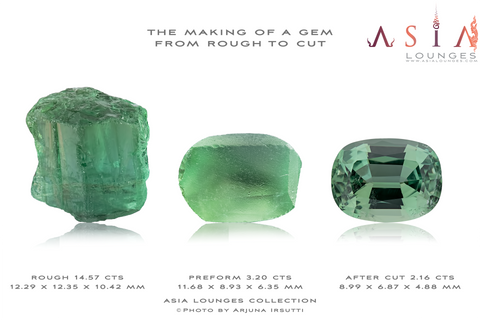Hey Loungers,
Have you heard of Tourmalines before? If not, read on as Jeff "Master" Bergman takes us through this lovely and colorful family of gems!
Tourmaline's name comes from the Sinhalese word "turmali," which means "mixed." Bright rainbow collections of gemstone varieties were called "turmali" parcels. Tourmalines, occurring in more colors and combinations of colors than any other gemstone variety, lives up to its name. There is a tourmaline that looks like almost any other gemstone! Many stones in the Russian Crown jewels from the 17th Century once thought to be rubies are actually tourmalines.
Learn more about this fabulous gem by clicking on this link.
Perhaps this is why this gemstone is said to encourage artistic intuition: it has many faces and expresses every mood.
The Empress Dowager Tz'u Hsi, the last Empress of China, loved pink tourmaline and bought almost a ton of it from the then new Himalaya Mine, located a long way from the Middle Country in California. The Himalaya Mine is still producing tourmaline today but the Dowager went to rest eternally on a carved tourmaline pillow.
Here is a fine example of California Pink Tourmaline.
Tourmaline is also of interest to scientists because it changes its electrical charge when heated. It becomes a polarized crystalline magnet and can attract light objects. This property was noticed long ago before science could explain it: in the Netherlands, tourmalines were called "aschentrekkers" because they attracted ashes and could be used to clean pipes!
An interesting example of Greenish Blue / Ashen colored Tourmaline
Tourmaline occurs in every color of the rainbow and combinations of two or three colors. Bicolor and tricolor tourmalines, with bands of colors are very popular. Sometimes the colors are at different ends of the crystal and sometimes there is one color in the heart of the crystal and another around the outside. One color combination, pink center with a green rind, is called "watermelon tourmaline" (seedless, of course!) Sometimes designers set slices of the crystal instead of faceted stones to show off this phenomenon.
A lovely example of a Bi-color tourmaline, this "rose" color gem features a more vivid pink pink color on the sides and a more brownish heart reminiscing of the color of the heart of a rose flower.
Almost every color of tourmaline can be found in Brazil, especially in Minas Gerais and Bahia. Pink and green colors are particularly popular. In 1989, miners discovered tourmaline unlike any that had ever been seen before. The new type of tourmaline, which soon became known as Paraiba tourmaline, came in incredibly vivid blues and greens. The demand and excitement for this new material, which soon fetched more than $10,000 per carat, earned more respect for the other colors of tourmaline.
Here is a nice example of a Paraiba - type tourmaline. While this gem is of Nigerian origin, it's copper content and peculiar color, akin to that of the Brazilian material, allows for the use of the term Paraiba - type described in the article above.
Pink and green tourmaline are now widely available and are especially popular in designer jewelry. Blue tourmalines are also very much in demand but the supply is more limited.
Tourmalines are most often cut in long rectangular shapes because of their long and narrow crystal shape. Tourmaline crystals are beautiful, pencil thin and ridged, and they are also sometimes set in jewelry. Some designers also set rainbows of tourmaline in each color of the spectrum. Tourmaline is strongly pleochroic: the darkest color is always seen looking down the axis of the crystal.
In addition to Brazil, tourmaline is also mined in Tanzania, Kenya, Madagascar, Mozambique, Namibia, Afghanistan, Pakistan, Sri Lanka, and California and Maine in the United States. Maine produces beautiful sherbet colors of tourmaline and spectacular minty greens. California is known for perfect pinks, as well as beautiful bicolors.
If you want to know more about rough and cut, feel free to read on this earlier post from our teams!
One particularly beautiful variety is chrome tourmaline, a rare type of tourmaline from Tanzania which occurs in a very rich green color caused by chromium, the same element which causes the green in emerald.
Tourmaline is a hard and durable gemstone which can withstand years of wear. You might want to avoid steam cleaning or heat.
©Jeffery L Bergman, SSEF SGC






